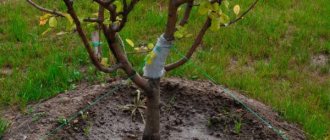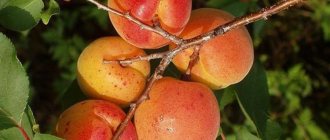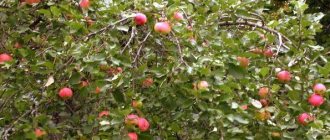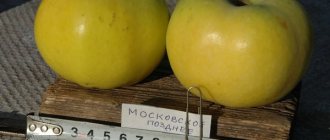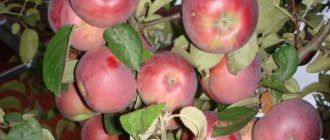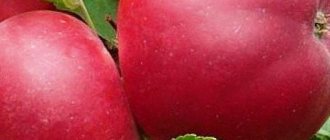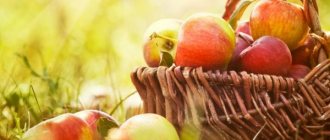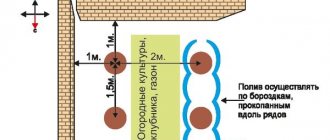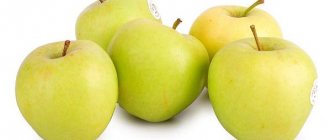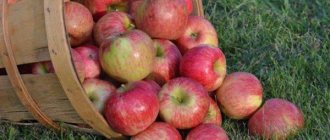Photo by the author.
Every person uses apples in their diet to one degree or another. Some eat them straight from the branch, enjoying the aroma and juiciness, some bake them, others make jam or distill the juice, dry or can them. But it is obvious that apples are one of the most popular products in Russian gardening. And the apple tree on the site is as integral a part of Russian nature as beds with strawberries or thickets of raspberries. It is impossible to imagine a garden without apple trees, in the shade of which it is so pleasant to relax on hot summer days. And one of the most vivid memories of a “country” childhood are apples from a neighboring garden, which are always tastier than their own... And even now, almost any gardener who has a small allotment and a love for the land will definitely plant an apple tree on his plot.
When choosing an apple tree for your garden, you must first of all be guided by your desires and needs. There are lovers of sour things, others love sweet, pourable apples, and still others need the maximum amount of juice from this fruit. And there are those who are ready to grow apples for sale, choosing varieties of the desired marketable type, taste and keeping quality. Are there not enough desires in the world? In addition to personal preferences, when choosing a variety, it is necessary to take into account such a concept as winter hardiness of the apple tree, especially when talking about gardens in the middle zone. By winter hardiness we mean the frost resistance of the tree and its roots, resistance to unfavorable weather changes in the spring and autumn, as well as frost after a thaw in the winter. Moreover, the last factor is very important for the Non-Black Earth Region, where winter thaws and recurrent frosts often occur . Hence the first conclusion: only zoned varieties should be grown. What is good in America and Siberia for the Moscow region can turn into a disaster. The “Americans” will freeze to death, and the “Siberians” will not fare well either. The second criterion when selecting an apple tree is its resistance to diseases, and first of all, to such a scourge of apple trees as scab. There are two options for solving this problem. The first is to plant trees highly resistant to scab in the garden, the second is to fight this fungal disease with drugs that reduce and in some cases eliminate this disease (“Abigapik”, “Skor”, “Rayok” according to the instructions). When planting an apple tree in the garden, you need to pay special attention to the quality of the seedling. It’s a shame to lose several years because the grafting was initially of poor quality or the root system was not developed enough. Garden center consultants will help you resolve this issue. Proper planting of the tree and regular and careful care of it are of no small importance.
The question of the number of trees in the garden is decided based on the size of the plot and the needs of the gardener, but it should be noted that the presence of summer, autumn and winter varieties greatly simplifies the task of choosing apple tree varieties. Summer varieties include varieties of apple trees whose fruiting period is July–August. Such apples are immediately ready for consumption and have a short shelf life. Autumn varieties include apple trees, the ripeness of the fruits of which occurs in early to mid-September, and consumer maturity - 2-3 weeks after harvest. These apples can be stored for 2–3 months. Winter varieties include apple trees, the fruits of which are harvested at the end of September and later. Some varieties can eat these apples right away, but for the most part, consumer maturity occurs after a month or more, and such apples are stored for 3–5 months or more.
Next, I will talk about the most interesting varieties that I usually recommend to gardeners:
Dawn
Apple tree variety Rassvet
Dawn
– a variety of early summer (3rd ten days of June – 1st ten days of July) ripening period. The tree is medium-sized, needs summer pruning, bears fruit regularly. The variety is immune to scab and highly resistant to powdery mildew. The extremely early ripening period of fruits is combined with their good transportability. The advantages of the variety also include early fruiting, spectacular coloring of the fruits (when ripe they become covered with a bright crimson blush), high taste qualities of the fruits (4.8 points).
Immune varieties of apple trees for regions
It is necessary to select apple trees immune to scab according to the climatic conditions of a particular region. This is important, because climatic conditions may vary, which affects the development of the plant as a whole and the ripening of fruits.
North-West Russia
The climate of the North-West is characterized as temperate and subarctic.
Due to the fact that precipitation does not have time to evaporate, although there is not much of it, the humidity is increased and many reservoirs form in the area.
Here are the scab-resistant trees you should choose for your region:
- Victory. A tall tree with a rounded crown does not have many branches. Late winter fruits are green when picked, large in size, and have a pleasant taste. They are easily stored until spring, at which time they acquire their best taste. The tree and fruits have strong immunity to scab and other fungal diseases, even in conditions of high humidity;
- Friendship. A late summer variety that can be stored until October, but only under proper conditions. The tree is large and large and produces fruit regularly at a young age. The fruits have a dessert taste, yellow with a red blush and a persistent aroma.
Apple tree Victory.
Ural
The climate of the Urals is mountainous, continental, close to cold-temperate. In some places there are areas with increased rainfall, even in the driest months.
Here are the most suitable for the Urals:
- Pervouralskaya. An amazing feature of the variety is that it is resistant to all possible types of scab. A tall tree produces a bountiful harvest of beautiful, tasty apples that can easily be stored until spring;
- Veteran. The early-fruiting tree produces a high yield of apples with a dessert taste. Over time, fruiting only increases.
Apple tree Pervouralskaya.
Siberia
The climate of most regions of Siberia is quite harsh. Therefore, in addition to resistance to scab, the ability to survive a cold and long winter will also be important for Siberian apples.
Here are the apple trees immune to scab that are planted under these conditions:
- Golden summer. The variety of this tree is distinguished by incredibly tasty fruits. Although they do not have a long shelf life, their scope of application is very wide. Fruits are used for making jams, compotes, drying and baking;
- Lyubava. This winter variety produces tender, juicy fruits that are stored for a long time. The tree has an amazing aesthetic appeal - it is tall, slender and round.
Apple tree Lyubava.
Central Russia
In the conditions of the middle zone, all the same varieties as in the Urals can feel comfortable.
In addition to them, the following are successful:
- Aport. An unpretentious species with late autumn or winter fruiting. The apples are large and are located in large quantities on powerful trees;
- Rozhdestvenskoe. The high immunity to various diseases of a fast-growing tree will undoubtedly resonate with many gardeners. Moreover, tasty and beautiful apples will delight everyone until Christmas.
Apple tree Aport.
North Caucasus region and Stavropol region
The light and comfortable climate of this region, together with the rich soil of this region, gives wide scope for imagination. The temperature conditions of the North Caucasus do not have strong and sudden changes.
In addition to other scab-resistant varieties for Caucasian placement, it is worth paying attention to these:
- Jonathan. A late-winter representative that produces tasty, small-sized fruits. They are sour with an unusual sweetness and a persistent aroma;
- Wagner prize money. A small tree with large red fruits. Autumn fruits with a pleasant sweet and sour taste are stored until the beginning of spring.
Apple tree Jonathan.
Ukraine
The favorable climate of Ukraine makes it possible to grow various varieties of apples with immunity and high resistance to scab.
Pay attention to:
- Goldstar. Representative of a winter variety with tasty fruits. The tree is tall, strong, frost-resistant;
- Pinova. A fast-growing and productive variety that produces a bountiful harvest. The fruits are tasty, juicy, rosy.
Apple tree Goldstar.
Moldova
The favorable climate allows you to choose different common varieties.
Among others, you can safely pay attention to:
- Idared. A late-winter variety of apple tree with a high and spreading crown. The fruits are large, one-dimensional, light green and almost completely covered with blush;
- Florina. A small, compact tree with a dense crown is distinguished by abundant fruiting. The fruits are medium or large, sweet and sour with thick skin. They store well until spring and during this time they acquire a pleasant melon aroma.
Apple tree Idared.
Belarusian varieties
The varieties that were bred in Belarus, however, are widely grown and are known to many amateur and professional gardeners far beyond its borders.
Here are some of them:
- Memory of Syubarova. Winter, productive variety with a good sweet and sour taste and persistent aroma. The plant is distinguished by stable fruiting and the ability to withstand any bad weather;
- Nadzeiny. A productive late-winter variety with high frost resistance. Fruits of mediocre taste are most often used for processing;
- Darunak. Winter-hardy variety with excellent immunity to scab. Green juicy and sweet apples are completely covered with blush;
- Enchantress. Medium-sized tree with mixed fruiting. The fruits are medium in size, regular in shape with yellow skin, along the perimeter of which there is a rich red blush.
Apple tree Memory of Syubarova.
Fairy
Fairy apple tree
Fairy
– an early summer ripening variety. Tree of moderate growth, compact, fruiting regularly. The variety is resistant to scab and powdery mildew, and drought-resistant. The fruits are green in color, larger than average in size and large (average weight 203 g), which is very valuable for an early summer variety. The pulp is greenish, medium density, tender, juicy, good sweet and sour taste (4.5 points), with a delicate aroma. Removable fruit maturity occurs in the third decade of June - early July. In the refrigerator, the fruits can be stored for up to a month or longer. Recommended for children's and dietary nutrition.
Ways to fight
There are a number of measures to successfully combat scab on apple trees, as well as prevent its appearance on fruit trees. Methods of protection include preventive measures and treatment of identified fungal diseases. Competent prevention helps prevent the onset of the disease, but if signs of scab are detected, the fight against it must begin as soon as possible to prevent it from spreading to other trees.
For varieties prone to fungal infection, regular treatments are mandatory.
Preventive measures include :
- planting trees in compliance with the recommended distance, since diseases spread faster on apple trees growing too close to each other;
- choosing scab-resistant varieties - this is especially true for areas with a humid climate;
- regular sanitary pruning of the crown;
- caring for tree trunks, cleaning leaves and fallen fruits in the autumn garden, burning foliage and pruned branches;
- removing weeds, as they can also contribute to the spread of fungal spores;
- use of fungicidal drugs. You can also learn about effective means and timing of treatments from another article on our website.
To prevent and treat scab on apple trees, chemical agents must be used. In early spring, while the buds have not yet awakened, the trees and soil in the tree trunk circle are treated with nitrafen or urea. For spraying, a 5% solution is used (500 g of urea per 10 l of water), and for soil - a more concentrated, 7% solution (700 g per 10 l of water). The drugs can be combined and alternated, using, for example, urea for spraying a tree, and nitrafen for treating the soil, or vice versa.
The first treatment is carried out in early spring before the buds awaken
When the buds begin to bloom, in the so-called “green cone” phase, it is recommended to spray with a 3% solution of Bordeaux mixture, and during the period of bud separation and after flowering – with a 1% solution. Instead of Bordeaux, other drugs are used: polychome, copper oxychloride, polycarbacin.
If the weather is humid and warm, then approximately 15-20 days after the end of flowering, another spraying of the trees with Bordeaux mixture is carried out. Treatments at the stage of ovary formation are used when the disease is severely affected; usually, previous measures help get rid of scab on the apple tree.
Treating apple trees against scab in the spring according to the described scheme gives good results and allows you to protect and cure trees from this formidable disease. However, fungicides should be used in minimal dosages and only in cases where this is really necessary.
Preparation of Bordeaux mixture
Bordeaux mixture is the most common fungicide, which was invented about 100 years ago and is still used by gardeners around the world. The mixture for its production is sold in specialized stores; the packaging contains two bags of dry substances, one containing copper sulfate, and the other containing slaked lime.
Bordeaux can be purchased as a ready-made liquid or dry mixture
To get 1% Bordeaux mixture, you will need:
- 100 g of copper sulfate;
- 100 g slaked lime;
- 10 liters of water;
- two 10-liter buckets (plastic or enamel, galvanized containers cannot be used);
- gauze for straining the solution;
- respirator and gloves.
100 g of copper sulfate is poured into one bucket and 1 liter of moderately hot water (temperature about 50 ℃) is added. The solution is stirred, another 4 liters of water are added and left to cool.
Pour 100 g of lime into another bucket and pour in about 1 liter of cold water, stir gently and bring the volume of the solution to 5 liters, adding cold water. The result is a white liquid, which gardeners call “milk of lime.”
After complete cooling, the copper sulfate solution is poured into the “milk of lime” in a thin stream; the opposite cannot be done. When mixed, the liquid acquires a beautiful blue color.
The combined solution is mixed and filtered through gauze so that there are no lumps. The resulting liquid should not be too concentrated, otherwise it may cause burns on the leaves. To check, take a clean iron nail and dip it in the prepared liquid. If the metal turns red, then the concentration of the solution is too high and it must be diluted with “milk of lime” or water.
To obtain a 3% solution of Bordeaux mixture, all work is performed according to the same scheme, but take 300 g of copper sulfate and lime per 10 liters of water
The finished Bordeaux mixture is poured into a sprayer and used to treat trees. It must be used on the day of manufacture, as the properties are lost over time.
When using chemicals, we must not forget about protective equipment - gloves, a respirator, special clothing. Spraying is recommended on dry, cool days, preferably early in the morning or evening. Trees should not be treated in strong winds or before or after rain. This work should not be carried out during apple tree blossoms in order to protect bees and other pollinating insects.
For detailed recommendations from a specialist on the preparation and use of Bordeaux mixture, see the video:
Red amber
Red amber
– an early summer ripening variety. The tree is medium-sized. It is immune to scab and resistant to powdery mildew, frost resistance is above average, and drought resistance is high. The fruits are larger than average and large (185–210 g), elegant, with a spectacular bright red color, harmonious sweet and sour taste (4.7 points), with a delicate aroma. Removable fruit maturity occurs at the end of the first - beginning of the second decade of July. In the refrigerator, the fruits are stored until the end of August.
Triploid apple varieties with the vf gene
Separately, I would like to draw attention to varieties of apple trees with a triple set of chromosomes, the so-called triploid. These are those that are distinguished by the best qualities: abundant harvest, tasty fruits and resistance to scab. It is the vf gene that is responsible for resistance to this fungal disease.
Here are the ones worth paying attention to:
- summer variety Augusta, whose name hints at the timing of harvest;
- winter - Rozhdestvenskoe, which is harvested at the beginning of autumn and gains taste for the winter holidays and Memory of Semyakin, a winter productive variety with excellent taste.
And work is also underway on immune varieties:
- Rock;
- Prima;
- Moscow Anniversary;
- Jubilee;
- Sun.
Rozhdestvenskoye apple tree variety.
On the resistance of some apples to scab
Not all plants are enviably resistant to fungal diseases. But some of them are so familiar and loved that you want to look after and care for them in order to protect them from this scourge. All for the sake of obtaining tasty and long-loved fruits.
This is for example:
- Belarusian guest Elena;
- sweet summer variety Sweet bliss;
- promising Souvenir and its subtypes;
- large and tasty Bogatyr.
fontanel
fontanel
– a summer ripening variety. Tree of moderate growth. The variety is characterized by high resistance to scab and powdery mildew, drought and frost resistance. The fruits are large (weighing 210 g or more), green in color with a blurred crimson blush on the sunny side. The pulp of the fruit is very juicy (that’s why the variety is named Rodnichok), sweet and sour, with a delicate aroma (4.5–4.6 points). Removable fruit maturity occurs at the beginning of the second ten days of July. The consumer period lasts until the end of August. Among the advantages of the variety are early fruiting (beginning of fruiting in the 2nd year), high yield of clarified juice.
Popular varieties
Due to the wide variety of known types of apple trees, we can highlight those that are the most popular. These varieties are found most often in summer cottages, and gardeners continue to grow them with pleasure and speak only positively about apple trees.
"Pouring white"
The long-known species began to be grown in Russia several decades ago. It is most widespread in the central part of the country. Filling ripening is early and occurs at the height of summer. The weight of apples is small, up to 100 grams. The color of the skin is yellow-green. The variety has average resistance to scab, so spring treatment with fungicides or copper sulfate will not harm.
Attention! For abundant fruiting, the apple tree needs to be fed with potassium supplements during the flowering period and before its onset.
"Arkadik"
The variety was bred by Russian breeders taking into account the temperate climate in central Russia. Large fruits have a sweet-sour taste and a pleasant aroma. Arkadik matures in the summer, in the first half of it. The variety is characterized by high resistance to scab; its roots are prone to rotting.
"Mantet"
This species came to Russia from Poland. It has good frost resistance and can be grown in the Moscow region. The pulp is very tender and sweet. Apples are mainly grown for fresh consumption. The fruits look beautiful and appetizing. The variety is self-fertile and does not require pollinators. The disadvantages include the late period of fruiting, which usually occurs in the fifth or even sixth year after the tree begins to grow.
"Bogatyr"
Bogatyr has excellent immune abilities; the name of the variety speaks for itself. The apple tree almost never gets sick. Ripening begins in September and occurs until late frosts, while the apples hang on the branches and do not fall for quite a long time. The fruits are large, weighing up to 300 grams. According to the taste rating, the variety received 4.5 points. Bogatyr is characterized by high productivity; even in a bad and rainy summer, the figure will not drop below 100 kilograms from a tree 5-7 years old.
Even despite the high resistance to scab in many varieties, preventive annual treatment of trees should not be forgotten, much less neglected. Scab infection begins in early spring, when the buds are just opening. To prevent shoot disease, the apple tree is sprayed with fungicidal preparations at this time. You can use Bordeaux mixture or copper sulfate instead of fungicides. Spray the entire tree, including the area of the ground near the trunk circle. If such a procedure is carried out regularly, the apple tree will not get sick, and its life expectancy will be 20 years or more.
Union
Union
– a summer ripening variety. The tree is medium-sized. It is immune to scab and highly resistant to powdery mildew. The fruits are very large (up to 355 g), the main color is light green; when ripe, the fruits become covered with a bright crimson (and sometimes even burgundy) blush. The pulp is juicy, has an excellent dessert taste, with a refined aroma. Tasting taste score 4.8–4.9 points. The fruit ripening period is the 2nd decade of July. Fruits can be stored in the refrigerator for two months or longer.
Fortune
Apple tree variety Fortuna
Fortune
– a summer ripening variety. The tree is medium-sized. The variety is immune to scab, highly resistant to powdery mildew, and drought and frost resistant. Early fruiting, requires strong anti-aging pruning. Thinning of the fruits is recommended, since they may become smaller if overloaded with the harvest. The fruits are larger than average in size (180–235 g), the main color is greenish-yellow, the outer color is dark maroon throughout almost the entire fruit when fully ripe. The pulp is creamy, medium density, juicy, harmonious sweet and sour taste (4.8 points), with a delicate aroma. Removable fruit maturity occurs at the end of July. In the refrigerator, the fruits are stored until September. Transportability is high.
Golden summer
Golden summer
– a summer-ripening variety, bred with the participation of the Golden Delicious variety and is similar to it in the taste of the fruit. The tree is weak-growing. The variety has complex resistance to scab, powdery mildew and fruit rot, and is drought and frost resistant. Productivity is high and regular. The fruits are medium-sized - weighing approximately 160 g, maximum weight 250 g, truncated-conical in shape. The color of the fruit during the period of removable ripeness is greenish-yellow, and at consumer ripeness it is golden-yellow. The pulp has a dessert taste, with a delicate aroma. Tasting assessment of fruit taste 4.7 points. Recommended for children's and dietary nutrition.
Scab: what is it and why does it affect apple trees?
Scab is a real scourge of domestic gardens. It affects fruits and leaves. Leads to deterioration of the condition of fruit plants, reduces their winter hardiness, and has a bad effect on yield.
The spread of scab is due to the following factors:
- Creation of large gardens.
- Extreme wintering conditions.
- Dense placement of apple trees.
- Deterioration of the environmental situation.
Previously, scab was combated by treating it with special chemicals. At the same time, the quality and usefulness of the fruits decreased. Today, immune varieties of apple trees make it possible to avoid such problems. Experienced gardeners have already appreciated all the benefits of growing scab-resistant varieties.
Talida
Talida apple tree
Talida
– winter ripening variety. Tree of moderate growth. The variety is highly resistant to scab and powdery mildew, and is frost-resistant. The fruits are large (270–365 g), round in shape. The main color is greenish, the integumentary color (may appear in years with a sharp difference in day and night temperatures, which enhances the color) - in the form of a delicate pink blush. The pulp is juicy, aromatic, with excellent sweet and sour taste (tasting score - 4.8 points). The fruits store well and are used fresh. Transportability is high.
Margot
Margot
– winter ripening variety. Tree of moderate growth. The variety is immune to scab, resistant to powdery mildew, frost- and drought-resistant. The fruits are large (up to 234 g), oblong in shape. The main color of the fruit is greenish-yellow, the outer color is absent. There are many subcutaneous points. The pulp is creamy, juicy, aromatic, dessert sweet and sour taste (4.7 points). Harvesting maturity occurs in the third ten days of September. The fruits are well stored. Used fresh. Recommended for children's and dietary nutrition. Transportability is high.
Orpheus
Orpheus
– winter ripening variety. Tree of moderate growth. The variety is immune to scab, resistant to powdery mildew, and drought-resistant. The fruits are large (up to 292 g), oblong-conical. The main color of the fruit is greenish-yellow, the outer color is very pronounced, blurred, crimson. There are few subcutaneous points. The pulp is creamy, juicy, aromatic, with excellent sweet and sour taste (4.8 points). Removable fruit maturity occurs in the third ten days of September. The fruits store well and are used fresh. Transportability is high.
E. Ulyanovskaya, Doctor of Agricultural Sciences, North Caucasus Zonal Research Institute of Horticulture and Viticulture, Krasnodar.
Pure-grade planting material of these varieties can be purchased only at the Garden Center of SKZNIISiV at the address: 350901, Krasnodar, st. 40 years of Victory, no. 39; contact numbers: (8–861) 252–66–21, 252–65–59.
